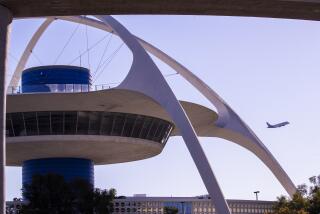Commentary : Truce May Be Near in a Regulation War in Skies Over Wayne Airport
- Share via
In 1987 general (non-airline) aviation experienced one of its safest years ever. But relations between the national aviation community and the governmental agency responsible for the regulation of aeronautics, the federal Aviation Administration (FAA), were the worst ever.
Lying in the balance has been the issue of air safety over high-density metropolitan areas such as Orange County. The John Wayne/Santa Ana airport is the fifth busiest in the nation, with more than half a million annual flight operations. Yet, the Orange County skies are largely uncontrolled by the FAA, with more than 90% of John Wayne’s operations consisting of general aviation.
Recognizing the mid-air collision potential generated not by the volume, but the incompatible mix of airliners and smaller aircraft, the FAA and aviation community have long pondered the need for increased radar control over Orange County airspace. But when the FAA recently announced plans for an Airport Radar Service Area (ARSA) at John Wayne, the aviation community braced itself for yet another bitter battle in its ongoing state of war with the government. The community’s reaction was not unjustified.
The air war between the regulator and the regulatees began as a result of the August, 1986, Cerritos midair collision. In an ill-advised move to “get tough” on air safety (and head off Cerritos criticism), the FAA closed a vital corridor of airspace used by small aircraft over the Los Angeles International Airport (LAX) in August, 1987.
Fearing the FAA’s action would only increase the probability of an air disaster east of LAX, the national aviation community and air traffic controllers filed an unprecedented lawsuit against the FAA. The resulting legal and political pressure forced the FAA to reopen the corridor in March, 1988. The battle intensified in March, however, when threatened litigation again forced the FAA to drop a discriminatory plan drastically curtailing LAX access to non-airline traffic during runway reconstruction.
Finally the April announcement of an FAA plan requiring nationwide installation and use of altitude encoding transponders (devices which “paint” an aircraft’s altitude and position on air traffic controllers’ radar scopes) escalated the air war to the national level. Intense congressional and public criticism of the ill-advised proposal resulted in its substantial modification, as well as a number of “reassignments” within the agency.
It was in this aftermath that the FAA unveiled plans for the Santa Ana radar service area. An ARSA is a cylinder of airspace 20 miles in diameter, resembling an inverted wedding cake over the airport. Aircraft passing through the ARSA would first be required to obtain a radio clearance from a radar approach controller, in addition to one from the John Wayne airport tower controller, before departing from or landing at the airport. Expecting the worst, the aviation community was shocked to discover that this time the FAA was bearing a white flag.
The clear problems in implementing an ARSA at the fifth busiest airport in the nation prompted the FAA not just to exercise a refreshing level of agency caution. The FAA also asked the community for its advice and assistance. The gesture was highly appropriate and long overdue.
With radar controllers already in short supply, installation of an ARSA may enlarge the collision danger. A busy radar air traffic controller is required to establish contact with all aircraft in the area, even where there is no purpose in doing so. His attention is necessarily distracted from other aircraft, such as jetliners, genuinely requiring the best possible radar air service. The resulting potential for another Cerritos is obvious.
At the FAA’s unprecedented invitation, the experts within the aviation community by consensus instead devised a “Santa Ana Special Flight Rules Area” (SFRA). The SFRA utilizes climb and descent corridors which resemble a bow tie on aeronautical charts. Unlike the cumbersome 130-cubic-mile ARSA, the 67.8-cubic-mile SFRA provides tailor-made radar control protection within the areas where it’s needed the most: airspace occupied by airliner traffic to and from the airport. All other air traffic would remain outside these specialized corridors unless it has a particular need and appropriate clearance from air traffic controllers.
Contrasted with an ARSA, the SFRA allows fewer air traffic radar controllers to provide better traffic separation and safety protection to the airliners and their passengers, with more efficiency. Also unlike the ARSA, aircraft not requiring special radar service protection around John Wayne Airport don’t get in the way of the airliners and don’t burden the controllers with needless clearances or unnecessary distractions.
The aviation community’s unanimous endorsement of the SFRA proposal may be a landmark step toward the genuine enhancement of air safety, both in Orange County skies and throughout the nation. Although a decision is not expected until late August, early feedback from the agency appears highly favorable.
The FAA’s remarkable new policy of glasnost is commendable. Cooperation of this kind, between government and the aviation community, is long overdue. Clearly it is also the only practical way to develop and implement our very best solutions to air safety problems.
As with our foreign polity concerns over glasnost , however, only time will tell whether that policy is one of sincerity, or yet another effort to placate those most adversely affected by bureaucratic intransigence. Ultimately at stake is whether the FAA truly has the right stuff to make critical air safety and airspace management decisions throughout the remainder of this century.
More to Read
Inside the business of entertainment
The Wide Shot brings you news, analysis and insights on everything from streaming wars to production — and what it all means for the future.
You may occasionally receive promotional content from the Los Angeles Times.










